[English] 日本語
 Yorodumi
Yorodumi- PDB-3l0w: Structure of split monoubiquitinated PCNA with ubiquitin in posit... -
+ Open data
Open data
- Basic information
Basic information
| Entry | Database: PDB / ID: 3l0w | ||||||
|---|---|---|---|---|---|---|---|
| Title | Structure of split monoubiquitinated PCNA with ubiquitin in position two | ||||||
 Components Components |
| ||||||
 Keywords Keywords | REPLICATION / DNA damage / DNA repair / DNA replication / DNA-binding / Isopeptide bond / Nucleus / Ubl conjugation | ||||||
| Function / homology |  Function and homology information Function and homology information: / : / : / : / : / Regulation of TP53 Degradation / Regulation of PTEN localization / : / UCH proteinases / : ...: / : / : / : / : / Regulation of TP53 Degradation / Regulation of PTEN localization / : / UCH proteinases / : / Aggrephagy / Peroxisomal protein import / : / positive regulation of DNA metabolic process / ABC-family proteins mediated transport / Mismatch repair (MMR) directed by MSH2:MSH6 (MutSalpha) / : / meiotic mismatch repair / Endosomal Sorting Complex Required For Transport (ESCRT) / Processive synthesis on the lagging strand / Removal of the Flap Intermediate / : / Polymerase switching / maintenance of DNA trinucleotide repeats / SUMOylation of DNA replication proteins / maturation of SSU-rRNA from tricistronic rRNA transcript (SSU-rRNA, LSU-rRNA,5S) / Translesion synthesis by REV1 / : / : / : / establishment of mitotic sister chromatid cohesion / PCNA complex / : / Recruitment and ATM-mediated phosphorylation of repair and signaling proteins at DNA double strand breaks / lagging strand elongation / : / DNA damage tolerance / silent mating-type cassette heterochromatin formation / mitotic sister chromatid cohesion / error-free translesion synthesis / Formation of the ternary complex, and subsequently, the 43S complex / Ubiquitin-Mediated Degradation of Phosphorylated Cdc25A / Translation initiation complex formation / Regulation of PTEN stability and activity / Ribosomal scanning and start codon recognition / CDK-mediated phosphorylation and removal of Cdc6 / FBXL7 down-regulates AURKA during mitotic entry and in early mitosis / Formation of TC-NER Pre-Incision Complex / Orc1 removal from chromatin / DNA polymerase processivity factor activity / MAPK6/MAPK4 signaling / Major pathway of rRNA processing in the nucleolus and cytosol / leading strand elongation / SRP-dependent cotranslational protein targeting to membrane / GTP hydrolysis and joining of the 60S ribosomal subunit / Gap-filling DNA repair synthesis and ligation in TC-NER / Formation of a pool of free 40S subunits / Nonsense Mediated Decay (NMD) independent of the Exon Junction Complex (EJC) / Nonsense Mediated Decay (NMD) enhanced by the Exon Junction Complex (EJC) / Antigen processing: Ubiquitination & Proteasome degradation / L13a-mediated translational silencing of Ceruloplasmin expression / Dual incision in TC-NER / ribosomal large subunit export from nucleus / Ub-specific processing proteases / translesion synthesis / subtelomeric heterochromatin formation / mismatch repair / positive regulation of DNA repair / positive regulation of DNA replication / replication fork / nucleotide-excision repair / maintenance of translational fidelity / modification-dependent protein catabolic process / protein tag activity / mitotic cell cycle / ribosome biogenesis / ribosomal small subunit assembly / ribosomal large subunit assembly / cytosolic small ribosomal subunit / cytosolic large ribosomal subunit / cytoplasmic translation / chromosome, telomeric region / protein ubiquitination / structural constituent of ribosome / ubiquitin protein ligase binding / DNA binding / zinc ion binding / identical protein binding / nucleus / cytosol / cytoplasm Similarity search - Function | ||||||
| Biological species |  | ||||||
| Method |  X-RAY DIFFRACTION / X-RAY DIFFRACTION /  SYNCHROTRON / SYNCHROTRON /  MOLECULAR REPLACEMENT / Resolution: 2.8 Å MOLECULAR REPLACEMENT / Resolution: 2.8 Å | ||||||
 Authors Authors | Freudenthal, B.D. / Gakhar, L. / Ramaswamy, S. / Washington, M.T. | ||||||
 Citation Citation |  Journal: Nat.Struct.Mol.Biol. / Year: 2010 Journal: Nat.Struct.Mol.Biol. / Year: 2010Title: Structure of monoubiquitinated PCNA and implications for translesion synthesis and DNA polymerase exchange. Authors: Freudenthal, B.D. / Gakhar, L. / Ramaswamy, S. / Washington, M.T. | ||||||
| History |
|
- Structure visualization
Structure visualization
| Structure viewer | Molecule:  Molmil Molmil Jmol/JSmol Jmol/JSmol |
|---|
- Downloads & links
Downloads & links
- Download
Download
| PDBx/mmCIF format |  3l0w.cif.gz 3l0w.cif.gz | 76.2 KB | Display |  PDBx/mmCIF format PDBx/mmCIF format |
|---|---|---|---|---|
| PDB format |  pdb3l0w.ent.gz pdb3l0w.ent.gz | 57.3 KB | Display |  PDB format PDB format |
| PDBx/mmJSON format |  3l0w.json.gz 3l0w.json.gz | Tree view |  PDBx/mmJSON format PDBx/mmJSON format | |
| Others |  Other downloads Other downloads |
-Validation report
| Summary document |  3l0w_validation.pdf.gz 3l0w_validation.pdf.gz | 439.5 KB | Display |  wwPDB validaton report wwPDB validaton report |
|---|---|---|---|---|
| Full document |  3l0w_full_validation.pdf.gz 3l0w_full_validation.pdf.gz | 462.1 KB | Display | |
| Data in XML |  3l0w_validation.xml.gz 3l0w_validation.xml.gz | 16.1 KB | Display | |
| Data in CIF |  3l0w_validation.cif.gz 3l0w_validation.cif.gz | 20.8 KB | Display | |
| Arichive directory |  https://data.pdbj.org/pub/pdb/validation_reports/l0/3l0w https://data.pdbj.org/pub/pdb/validation_reports/l0/3l0w ftp://data.pdbj.org/pub/pdb/validation_reports/l0/3l0w ftp://data.pdbj.org/pub/pdb/validation_reports/l0/3l0w | HTTPS FTP |
-Related structure data
| Related structure data |  3l0xC  3l10C  1plqS C: citing same article ( S: Starting model for refinement |
|---|---|
| Similar structure data |
- Links
Links
- Assembly
Assembly
| Deposited unit | 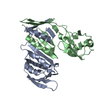
| ||||||||
|---|---|---|---|---|---|---|---|---|---|
| 1 |
| ||||||||
| Unit cell |
|
- Components
Components
| #1: Protein | Mass: 19238.893 Da / Num. of mol.: 1 / Fragment: N fragment Source method: isolated from a genetically manipulated source Source: (gene. exp.)  Gene: POL30, YBR0811, YBR088C / Plasmid: petduet-1 / Production host:  |
|---|---|
| #2: Protein | Mass: 18714.408 Da / Num. of mol.: 1 / Fragment: ubi-C fragment Source method: isolated from a genetically manipulated source Source: (gene. exp.)  Gene: POL30, UBI1 & Pol30, YBR0811, YBR088C / Plasmid: petduet-1 / Production host:  References: UniProt: P61864, UniProt: P15873, UniProt: P05759*PLUS |
-Experimental details
-Experiment
| Experiment | Method:  X-RAY DIFFRACTION / Number of used crystals: 1 X-RAY DIFFRACTION / Number of used crystals: 1 |
|---|
- Sample preparation
Sample preparation
| Crystal | Density Matthews: 4.04 Å3/Da / Density % sol: 69.54 % |
|---|---|
| Crystal grow | Temperature: 291 K / Method: vapor diffusion, hanging drop / pH: 6.2 Details: 2.04 M ammonium sulfate, 0.1 M sodium citrate, 3% ethanol, pH 6.2, VAPOR DIFFUSION, HANGING DROP, temperature 291K |
-Data collection
| Diffraction | Mean temperature: 100 K |
|---|---|
| Diffraction source | Source:  SYNCHROTRON / Site: SYNCHROTRON / Site:  ALS ALS  / Beamline: 4.2.2 / Wavelength: 0.97 Å / Beamline: 4.2.2 / Wavelength: 0.97 Å |
| Detector | Type: NOIR-1 / Detector: CCD / Date: Mar 25, 2009 / Details: saggitally focused mirrors |
| Radiation | Monochromator: saggitally focused mirrors / Protocol: SINGLE WAVELENGTH / Monochromatic (M) / Laue (L): M / Scattering type: x-ray |
| Radiation wavelength | Wavelength: 0.97 Å / Relative weight: 1 |
| Reflection | Resolution: 2.8→86.63 Å / Num. obs: 15333 / % possible obs: 100 % / Observed criterion σ(F): 0 / Observed criterion σ(I): 2 / Redundancy: 8.74 % / Biso Wilson estimate: 88.237 Å2 / Rmerge(I) obs: 0.109 / Net I/σ(I): 10.5 |
| Reflection shell | Resolution: 2.8→2.9 Å / Redundancy: 5.38 % / Rmerge(I) obs: 0.604 / Mean I/σ(I) obs: 2.4 / Num. unique all: 1471 / % possible all: 100 |
- Processing
Processing
| Software |
| |||||||||||||||||||||||||||||||||||||||||||||||||||||||||||||||||
|---|---|---|---|---|---|---|---|---|---|---|---|---|---|---|---|---|---|---|---|---|---|---|---|---|---|---|---|---|---|---|---|---|---|---|---|---|---|---|---|---|---|---|---|---|---|---|---|---|---|---|---|---|---|---|---|---|---|---|---|---|---|---|---|---|---|---|
| Refinement | Method to determine structure:  MOLECULAR REPLACEMENT MOLECULAR REPLACEMENTStarting model: pdb entry 1PLQ Resolution: 2.8→86 Å / Cor.coef. Fo:Fc: 0.909 / Cor.coef. Fo:Fc free: 0.875 / WRfactor Rfree: 0.323 / WRfactor Rwork: 0.285 / Occupancy max: 1 / Occupancy min: 0.25 / FOM work R set: 0.751 / SU B: 18.201 / SU ML: 0.365 / SU R Cruickshank DPI: 1.084 / SU Rfree: 0.421 / Cross valid method: THROUGHOUT / σ(F): 0 / σ(I): 2 / ESU R: 1.084 / ESU R Free: 0.421 / Stereochemistry target values: MAXIMUM LIKELIHOOD Details: HYDROGENS HAVE BEEN ADDED IN THE RIDING POSITIONS. U VALUES REFINED INDIVIDUALLY
| |||||||||||||||||||||||||||||||||||||||||||||||||||||||||||||||||
| Solvent computation | Ion probe radii: 0.8 Å / Shrinkage radii: 0.8 Å / VDW probe radii: 1.4 Å / Solvent model: MASK | |||||||||||||||||||||||||||||||||||||||||||||||||||||||||||||||||
| Displacement parameters | Biso max: 125.95 Å2 / Biso mean: 84.621 Å2 / Biso min: 20 Å2 | |||||||||||||||||||||||||||||||||||||||||||||||||||||||||||||||||
| Refinement step | Cycle: LAST / Resolution: 2.8→86 Å
| |||||||||||||||||||||||||||||||||||||||||||||||||||||||||||||||||
| Refine LS restraints |
| |||||||||||||||||||||||||||||||||||||||||||||||||||||||||||||||||
| LS refinement shell | Resolution: 2.8→2.873 Å / Total num. of bins used: 20
|
 Movie
Movie Controller
Controller



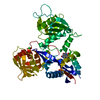
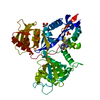


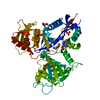

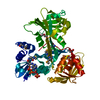
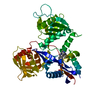
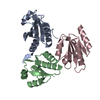
 PDBj
PDBj












